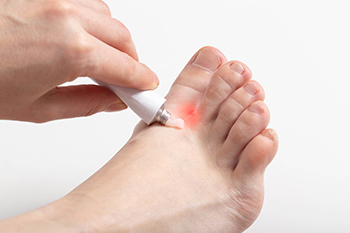Treating Athlete’s Foot
Tuesday, 13 August 2024 00:00 Athlete's foot, or tinea pedis, is a common fungal infection that affects the skin of the feet. It is caused by dermatophytes, fungi thriving in warm, moist environments like shoes, locker rooms, and swimming pools. Symptoms can include itching, stinging, and burning between the toes or on the soles, in addition to blisters, cracking, peeling, and dry skin. Risk factors include walking barefoot in communal areas, sharing footwear, having sweaty feet, and wearing tight-fitting shoes. People with weakened immune systems or diabetes are particularly susceptible. Treatment involves antifungal medications, available as creams, sprays, powders, or oral medications. Keeping feet clean and dry, changing socks regularly, and using antifungal powders can prevent recurrence. Complications can arise if left untreated, such as secondary bacterial infections, spreading to other body parts, and chronic infection. If you have a severe case of athlete’s foot, it is suggested that you visit a podiatrist for more aggressive treatment and medical supervision.
Athlete's foot, or tinea pedis, is a common fungal infection that affects the skin of the feet. It is caused by dermatophytes, fungi thriving in warm, moist environments like shoes, locker rooms, and swimming pools. Symptoms can include itching, stinging, and burning between the toes or on the soles, in addition to blisters, cracking, peeling, and dry skin. Risk factors include walking barefoot in communal areas, sharing footwear, having sweaty feet, and wearing tight-fitting shoes. People with weakened immune systems or diabetes are particularly susceptible. Treatment involves antifungal medications, available as creams, sprays, powders, or oral medications. Keeping feet clean and dry, changing socks regularly, and using antifungal powders can prevent recurrence. Complications can arise if left untreated, such as secondary bacterial infections, spreading to other body parts, and chronic infection. If you have a severe case of athlete’s foot, it is suggested that you visit a podiatrist for more aggressive treatment and medical supervision.
Athlete’s Foot
Athlete’s foot is often an uncomfortable condition to experience. Thankfully, podiatrists specialize in treating athlete’s foot and offer the best treatment options. If you have any questions about athlete’s foot, consult with one of our doctors from Coral Desert Foot & Ankle. Our doctors will assess your condition and provide you with quality treatment.
What Is Athlete’s Foot?
Tinea pedis, more commonly known as athlete’s foot, is a non-serious and common fungal infection of the foot. Athlete’s foot is contagious and can be contracted by touching someone who has it or infected surfaces. The most common places contaminated by it are public showers, locker rooms, and swimming pools. Once contracted, it grows on feet that are left inside moist, dark, and warm shoes and socks.
Prevention
The most effective ways to prevent athlete’s foot include:
- Thoroughly washing and drying feet
- Avoid going barefoot in locker rooms and public showers
- Using shower shoes in public showers
- Wearing socks that allow the feet to breathe
- Changing socks and shoes frequently if you sweat a lot
Symptoms
Athlete’s foot initially occurs as a rash between the toes. However, if left undiagnosed, it can spread to the sides and bottom of the feet, toenails, and if touched by hand, the hands themselves. Symptoms include:
- Redness
- Burning
- Itching
- Scaly and peeling skin
Diagnosis and Treatment
Diagnosis is quick and easy. Skin samples will be taken and either viewed under a microscope or sent to a lab for testing. Sometimes, a podiatrist can diagnose it based on simply looking at it. Once confirmed, treatment options include oral and topical antifungal medications.
If you have any questions, please feel free to contact one of our offices located in St. George and Kanab, UT, and Mesquite, NV . We offer the newest diagnostic and treatment technologies for all your foot care needs.




